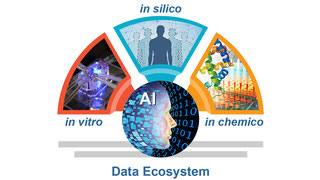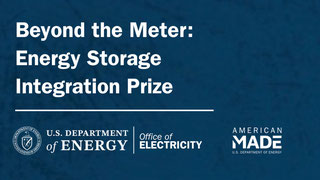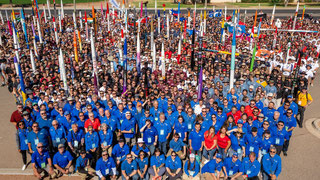Increasing Safe, Secure, Efficient Mobility through Air in Skies of 2035 and Beyond
Experts predict the skies of 2035 and beyond will be a complex and, at times, crowded space, populated with diverse vehicles piloted by both humans and machine intelligence. The estimates are that, twenty years from now, 10 million manned and unmanned vehicles may traverse the U.S. airspace every day. Our current system is not equipped to handle this volume or variety of aircraft.
To overcome the limitations of the current system and ensure safe access for all travelers and users of airspace, the Ab Initio Design (AbI) element of the NASA Safe Autonomous Operations Systems (SASO) Project is researching a new airspace design and concept of operations that will allow the air vehicles of 2035, including autonomous vehicles, to safely and efficiently participate in dense and diverse traffic. Clean-slate airspace architecture and operations, not constrained in the current system, are the overarching “Big Picture” target. Given the great complexity and scale of the of the overall objective, NASA is reaching out to the problem-solving community, asking innovators to cast aside the restraints of the current transportation model and develop component concepts and technologies that will enable the transition from the present system to the airspace of the future.
Background
The U.S. airspace system evolved over time in response to accidents and changing technology. Current operations support approximately 50,000 operations per day and boast the highest safety record of any mode of transportation, but this system has approached saturation and will not scale to accommodate future needs. Our goal is to build an airspace system that scales to 10 million vehicles per day (including personal air vehicles, passenger jets, unmanned vehicles of various sizes and speeds, stationary objects, space vehicles, etc.) by the year 2035.
To achieve this, a breakthrough in airspace system design and concept of operations is urgently needed as new vehicles -- such as drones of various sizes operating at different altitudes, commercial space launches, wind turbines in jet streams -- are already being introduced into the airspace. Architectural constraints of the current system may not allow it to accommodate the complex air traffic of 2035 and beyond. Thus NASA is looking for creative, clean-slate design constructs, or enabling component technologies and concepts, that will inform the design of real-world future air transportation.
We want airspace that can scale to full capacity under normal conditions and scale back to equally safe, reduced capacity under degraded conditions. Moreover, this adaptation has to happen autonomously. In addition, the airspace participants need self-protection from cyber-security attacks. Innovators who participate in this challenge will be asked to disregard current transportation infrastructure and constraints and use a clean-slate approach to conceptualize their designs, concepts of operations, and component technologies.
What Can You Do Right Now?
- Click the “Start Here” button above to register to compete in the challenge.
- Read the complete Challenge Guidelines to familiarize yourself with the rules and submission requirements for this challenge.
- Click the “Follow the Challenge” button above to be notified of any updates.
- Share this challenge with your friends and family or anyone who might be interested in creating the future. You can use the “Share” button beneath the challenge image above.
- Use the Comments section above to tell us what you think of the challenge or to ask any questions.
Definitions
For the purposes of this challenge, the following definitions hold:
The system: The set of all participants -- vehicles, controllers (human or automated), information services (ground or airborne), navigation services, sensor services, etc. -- in the airspace traffic.
Auto-characteristic or self-characteristic: An auto-characteristic or self-characteristic is an action performed by a participant in the system. This includes autonomy (self-governance, self-control, self-management); automation (performance of a task by a machine/software); self-monitoring, self-diagnosing, self-repair, self-protection, and self-optimization.
Guidelines
This challenge seeks to develop component concepts and technologies that will facilitate a transition to an airspace with dense, diverse and autonomous traffic. The following areas (not exhaustive) are of particular interest:
- All concepts and technologies related to auto- or self-characteristics of the system that support safe, efficient, and resilient traffic; for instance, methods and algorithms for self-organization and self-management in dense traffic. Consider the following example: in the present system, the paths of individual vehicles are approved by the air traffic control system. In a future autonomous system, it is anticipated that individual vehicles would be able to pursue their objectives with the smallest possible numbers of deviations from their optimal paths. However, when a group of vehicles has the same objective (say, flying to the same football game), increased density would require that the vehicles form organized flows to reach their destination efficiently and safely. This situation is similar to the current need for increased traffic control near and at airports. Concepts that allow groups of vehicles to self-organize dynamically, without external control, would be an example of self-organization.
- All concepts and technologies that improve the situational awareness in the system (e.g., sensors, information technology) in dense and diverse traffic.
- Security, including cyber-security of automated systems; and ensuring safety and security in the presence of non-cooperative participants.
Any other technologies and concepts, both large and small, that would facilitate a transition to a diverse and dense autonomous airspace, would be welcome for consideration.
Successful submissions will include the following elements:
- A description of the proposed technology or concept. Does it address vehicles in the system, the system services, or concept of operations? How does the technology interact with the system (e.g., with the other systems on a vehicle or other vehicles or other control)? On what existing and future technologies does the proposed technology or concept rely? Include a description of the world in which the technology will be operational. The metrics of success for the proposed technology/concept and its effects on the system should be clearly identified (efficiency, capacity, flexibility, predictability, delays, etc.)
- A detailed description of the proposed concept/technology functioning as related to a vehicle’s progression through the system, gate to gate or door to door or other uses of airspace.
- A detailed explanation of the proposed concept’s/technology’s impact on the system’s safety and security, with comparison to the current transportation system.
- An explanation of the concept/technology robustness (insensitivity to everyday disturbances) and resiliency (ability to spring back after major disturbances).
- An explanation of how the proposed concept/technology aids in transition from the present system to the future system that accommodates dense, diverse and autonomous traffic.
- Proposed solutions should be accompanied with substantiated discussions of major obstacles, both technical and societal, and potential approaches to overcoming them.
Judging Criteria
Evaluation of submissions will be weighted according to the following:
|
Points
|
Category
|
|
35
|
Originality and innovation shown in presented future scenario, designed solutions, and ideas
|
|
30
|
Substantiated, well-reasoned, realistic, and justified assumptions, discussion, design, and conclusions
|
|
25
|
Thorough and comprehensive pursuit of the problem; all types of stakeholders, vehicles, and airspace (e.g. altitudes) are addressed by the discussion and proposed solution
|
|
10
|
Presentation, organization, and clarity of submission; appropriate and clear use of figures, tables, and text
|
Submission Format
Submit your response in the form of a single PDF document (20 MB maximum). Responses are limited to no more than 15 pages total, including all sections and appendices. Submissions must be in English. Paper size must be 8.5 by 11 inches. Minimum margins are one inch. Font must be minimum 12 pt, single-spaced (text in tables and figures may be as small as 9 pt).
Challenge Prize
Prizes will be awarded to the top three submissions:
- First Place - $10,000
- Second Place - $3,000
- Third Place - $2,000
Challenge Timeline
- December 21st, 2015 - Challenge Launches
- February 26th, 2016 - Submissions Due
- March 31st, 2016 - Winners Announced
Additional Rules
Who can participate:
The Prize is open to all individuals, age 18 or older, private teams, public teams, and collegiate teams. Individual competitors and teams may originate from any country, as long as United States federal sanctions do not prohibit participation (see: https://www.treasury.gov/resource-center/sanctions/Programs/Pages/Programs.aspx). To be eligible to compete, you must comply with all the terms of the Prize as defined in the Challenge-Specific Agreement.
Registration and Submissions:
All innovators and teams must be registered prior to submitting an entry. Submissions must be received on or before February 26, 2016 at 11:59 pm EST. No late submissions will be accepted. Submissions must be made in English. All prize-related communication will be in English. Submissions must be made online (only), via upload to the HeroX.com website. All uploads must be in PDF format.
Selection of Winners:
Based on the winning criteria, 3 prizes will be awarded to the top three submissions: First Place - $10,000; Second Place - $3,000; Third Place - $2,000. In the case of a tie, the winner(s) will be selected based on the highest votes from the judges. NASA has absolute and sole discretion to determine whether to accept any submission, and whether to award one prize, multiple prizes or no prize based on the volume and content of submissions.
Additional Information:
- By participating in the Prize, each competitor agrees to submit only their original idea. Any indication of copying amongst competitors is grounds for disqualification.
- All applications will go through a process of due diligence; any application found to be misrepresentative, plagiarized, or sharing an idea that is not their own will be automatically disqualified.
- All ineligible applicants will be automatically removed from the competition with no recourse or reimbursement.
- No purchase or payment of any kind is necessary to enter or win the competition.
- Void wherever restricted or prohibited by law.









